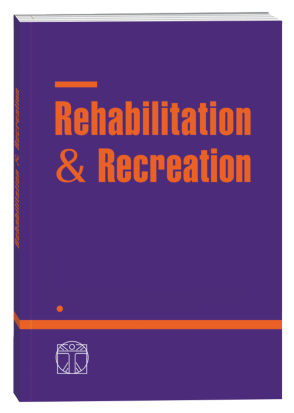MODERN TECHNOLOGIES TO THE CORRECTION OF MOTOR DISORDERS OF STROKE PATIENTS
Keywords:
stroke, rehabilitation, proprioceptive correctionAbstract
The effectiveness of the use of proprioceptive correction by PNF-therapy in patients in the
early recovery period of ischemic stroke was assessed. It is emphasized that spasticity is one of the
components of the central motoneuron affection syndrome, which often occurs in patients after a
stroke and has an adverse effect on their daily life activity. The significance of proprioceptive
correction methods in a comprehensive restoration of neurologic function in stroke patients was
shown. The dynamics of the neurological deficit, mechanisms of the action of proprioceptive
correction methods are analyzed. It has been proved that physical therapy, improved by the method
of proprioceptive neuromuscular therapy, provides more effective recovery of neurological deficit
of persons with consequences of ischemic stroke: reduction of severity of hemiparesis, restoration
of skills and increase in walking speed, restoration of self-service skills and increasing the level of
patient independence.
References
Міщенко Т. С. Аналіз епідеміології цереб- роваскулярних хвороб в Україні / Т. С. Міщенко // Судинні захворювання головного мозку. - 2010. - № 3. - С. 2-9. 2. Зінченко О. М. Стан неврологічної служби України в 2014 році : статистично-аналітичний довідник / О. М. Зінченко, М. В. Голубчиков, Т. С. Міщенко. - Харків, 2015. - 24 с. 3. Голик B. A. Восстановление двигательных функций после инсульта: влияние локализации патологических паттернов на прогноз / B. A. Голик // Судинні захворювання головного мозку. - 2011. - № 1. - С. 25-32. 4. Адлер Сьюзан С. ПНФ на практике / Сьюзан С. Адлер, Беккерс Доминик, Бак Мат / Под. ред. Т. В. Буйловой. - Нижний Новгород : Ридо-Принт, 2014. - 356 с. 5. Akosile C., Azikiwe N., Adegoke B., Johnson O., Awolowo O. Effects of proprioceptive neuromuscular facilitation technique on the functional ambulation of stroke survivors. Journal of the Nigeria Society of Physiotherapy. 2011. Vol. 18, No 19. P. 22-27. 6. Burke D., Culligan C., Holt L. The theoretical basis of proprioceptive neuromuscular facilitation. Journal of Strength and Conditioning Research. 2000. Vol. 14, No 4. P. 496-500. 7. Byuon S.H., Son H.H. The effects of proprioceptive neuromuscular facilitation and stabilizing exercise on trunk repositioning errors. Journal of Physical Therapy Science. 2012. Vol. 24. P. 1017— 1020. 8. Cheatwood J. L. Neuronal plasticity and functional recovery after ischemic stroke. Topics in stroke rehabilitation. 2008. Vol. 15. P. 42-50. 9. Hindle T., Whitcomb J., Briggs W.O. Proprioceptive neuromuscular facilitation (PNF): its mechanism and effects on range of motion and muscular function. Journal of Human Kinetics. 2012. Vol. 31. P .105-113. 10. Gontijo L. B., Pereira P. D., Neves C. D. et al. Evaluation of strength and irradiated movement pattern resulting from trunk motions of the proprioceptive neuromuscular facilitation. Rehabilitation Research and Practice. 2012. Vol. 14 (2). P. 196201. 11. Kawahira K., Shimodozono M., Ogata A., Tanaka N. Addition of intensive repletion of facilitation exercise to multidisciplinary rehabilitation promotes motor functional recovery of the hemiplegic lower limb. Journal of Rehabilitation Medicine. 2004. Vol. 36, № 4. P. 159-164. 12. Kim K., Lee D.K., Jung S.I. Effect of coordination movement using the PNF pattern underwater on the balance and gait of stroke patients. Journal of Physical Therapy Science. 2015. Vol. 27. P. 36993701. 13. Kim Y., Kim E., Gong W. The effects of trunk stability exercises using PNF on the functional reach test and muscle activities of stroke patients. Journal of Physical Therapy Science. 2011. Vol. 23. P. 699-702. 14. Kumar S., Kumar A., Kaur J. Effect of PNF technique on gait parameters and functional mobility in hemiparetic patients. Journal Exercise Science Physiotherapy. 2012. Vol. 8. P. 67-73. 15. Lacerda N. N., Gomes E. B., Pinehiro H. A. Effects of proprioceptive neuromuscular facilitation on postural stability and risk of falls in patients with sequelae of stroke: a pilot study. Journal Physiotherapy. 2013. Vol. 20. P. 37-42. 16. Lee C.W., Hwangbo K., Lee I.S. The effects of combination patterns of proprioceptive neuromuscular facilitation and ball exercise on pain and muscle activity of chronic low back pain patients. Journal of Physical Therapy Science. 2014. Vol. 26. P. 93-96. 17. Paneri N. A. Comparative study on to find the effectiveness of proprioceptive neuromuscular facilitation technique versus conventional trunk exercises to improve trunk control in recovery stage of hemiplegic patients. Journal Physiotherapy. 2014. Vol. 1(4). P. 178-186. 18. Tomasza W. Neuro-mobilizations combined with proprioceptive neuromuscular facilitation are effective in reducing of upper limb sensory in late- stage stroke subjects: a three-group randomized trial. Clinical Rehabilitation. 2010. Vol. 24. P. 810821. 19. Vishal S., Jaskirat K. Effect of core strengthening with pelvic proprioceptive neuromuscular facilitation on trunk, balance, gait, and function in chronic stroke. Journal of Exercise Rehabilitation. 2017. Vol. 13(2). P. 200-205.
Downloads
Published
How to Cite
Issue
Section
License
Copyright (c) 2017 Реабілітаційні та фізкультурно-рекреаційні аспекти розвитку людини (Rehabilitation & recreation)

This work is licensed under a Creative Commons Attribution-NonCommercial-NoDerivatives 4.0 International License.











